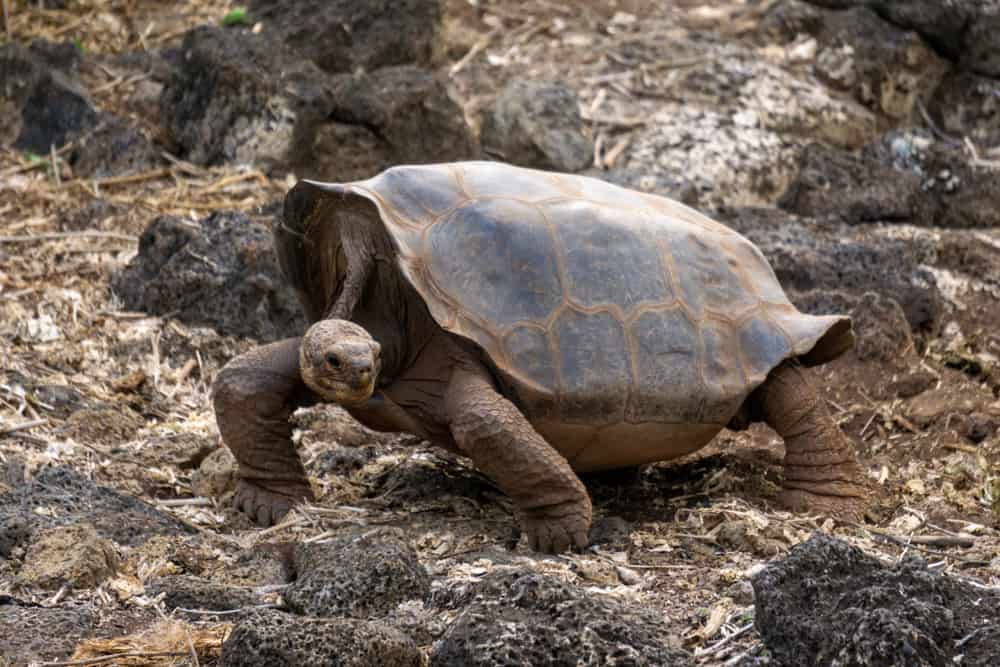Turtles and tortoises are one of the most popular animals in the world. With their interesting shells and slow movement, these animals gained an iconic status. They were often main characters in ancient fables, and today, they are popular comic and cartoon characters.
One of such comics and cartoons was Ninja Turtles, a franchise that popularized pet turtles and tortoises. Generations of children grew up watching Leonardo, Donatello, Michelangelo, and Raphael and naming their pets after them.
Still, many people don’t know the difference between a tortoise and a turtle, and they are often clueless about how to care for them. I was one of them until recently when I decided to get a tortoise pet, so I did a little bit of research. Here is what I found:
Tortoise VS Turtle
All tortoises are turtles, but not all turtles are tortoises. Turtles spend most of their lives in the water, while tortoises are exclusively land animals. That is why they developed some different characteristics, which can help you determine whether it is a turtle or tortoise.
Turtles have thinner and water-dynamic shells. Their legs are also more water-dynamic and longer, with webbed feet that serve as flippers when swimming. Also, turtles are omnivorous, which means their diet consists of both plants and other animals.
Tortoises, on the other hand, have more rounded, dome-like, thick shells. They have club-like front legs and elephantine hind legs. Their legs are built this way to support their weight. Tortoises are herbivores, feeding on the plants only.
The turtle’s shell also sheds its scutes to remove the old layers and make room for new growth. This helps their shells remain water-dynamic and lighter for swimming. Tortoises don’t shed their shells, and instead, their shells are constantly growing. This also has its benefits, as thicker shells protect tortoises from their predators.
The average turtle will live for 30-65 years, while the tortoises can live for 90 years on average, with some specimens living for more than 200 years.
Interesting Facts About Tortoises and Turtles
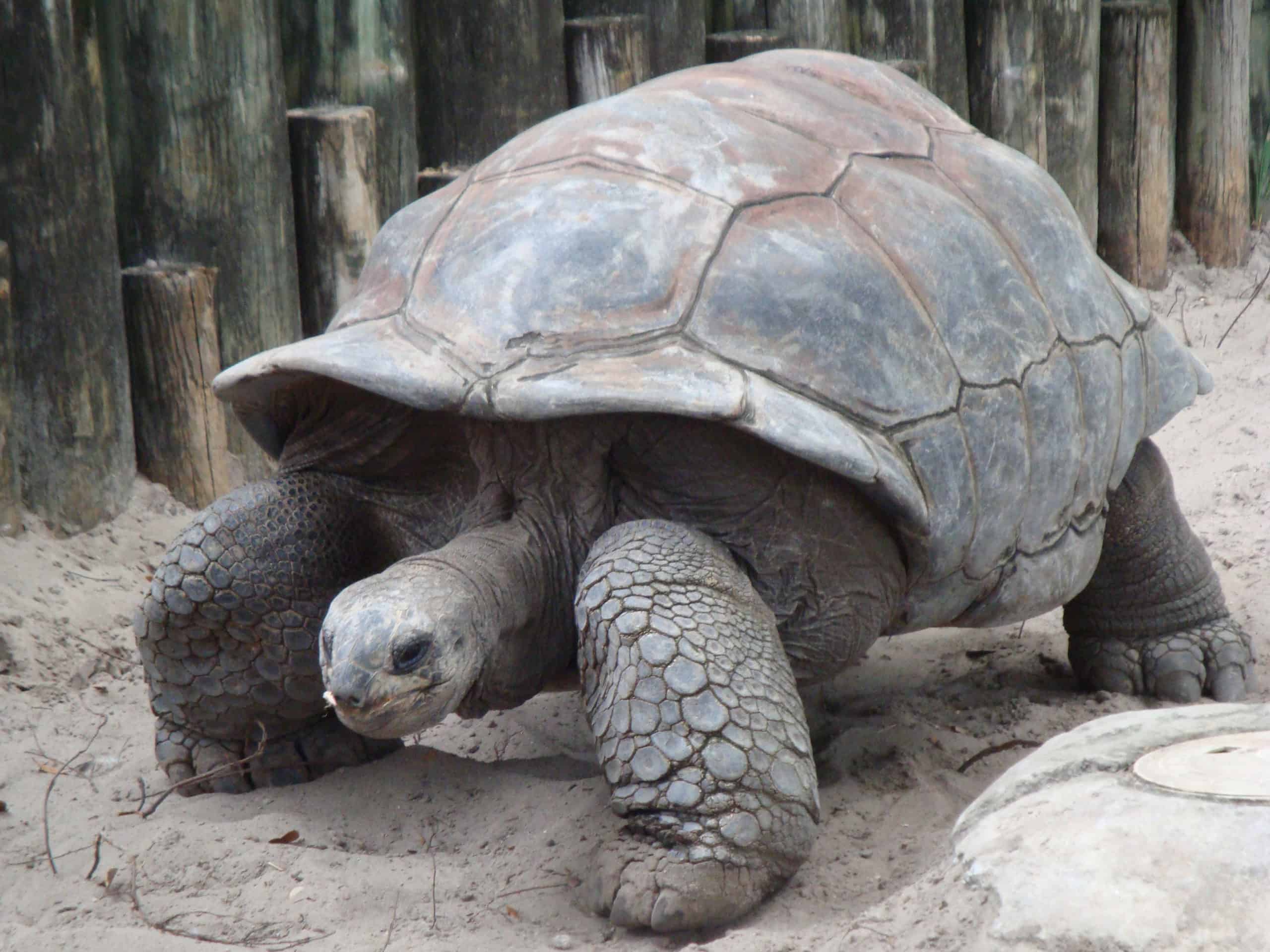
A group of tortoises is called creep. Turtles and tortoises are one of the oldest animals in the world, famous for their longevity. Not only do they live for long, but turtles are, among other reptiles, one of the oldest land animals.
Shell
Most people assume that turtle shells are some sort of exoskeleton, but they are actually modified rib cages. They have the second shell, also called a lower shell or plastron. The plastron is joined to the outer shell, called the carapace. These two shells create a complex shell box.
Reproduction
When some species lay their eggs, the weather conditions can influence whether the offspring will be male or female. When these eggs are laid during the lower temperatures, most of the babies will be male, and for females, eggs should be laid at higher temperatures.
After only one hour after birth, baby turtles lose their first tooth, called “egg-tooth”. The only function of this tooth is to help the baby turtle to break the egg shell.
Anatomy
The color of the tortoise can tell you what’s their natural habitat. A lighter shell means the tortoise came from a warmer country. Tortoises smell with their throats, as their nasal organ is located at the roof of their mouth.
Tortoises and turtles can produce a variety of sounds, depending on the species. Some produce chicken-like clucks, and others produce sounds similar to dog barking.
Speaking of tortoise’s mouths, these reptiles don’t have teeth, instead, they have bird-like beaks, which are sharp and ridged for meat-eating turtles, or serrated for herbivorous tortoises.
Space Travel
in 1968, the Soviet Union sent two tortoises into space. They drove in a spacecraft that circled the Moon before going back to Earth. They seemed to be well, except that they lost 10% of their body weight.
What Do Tortoises And Turtles Eat?
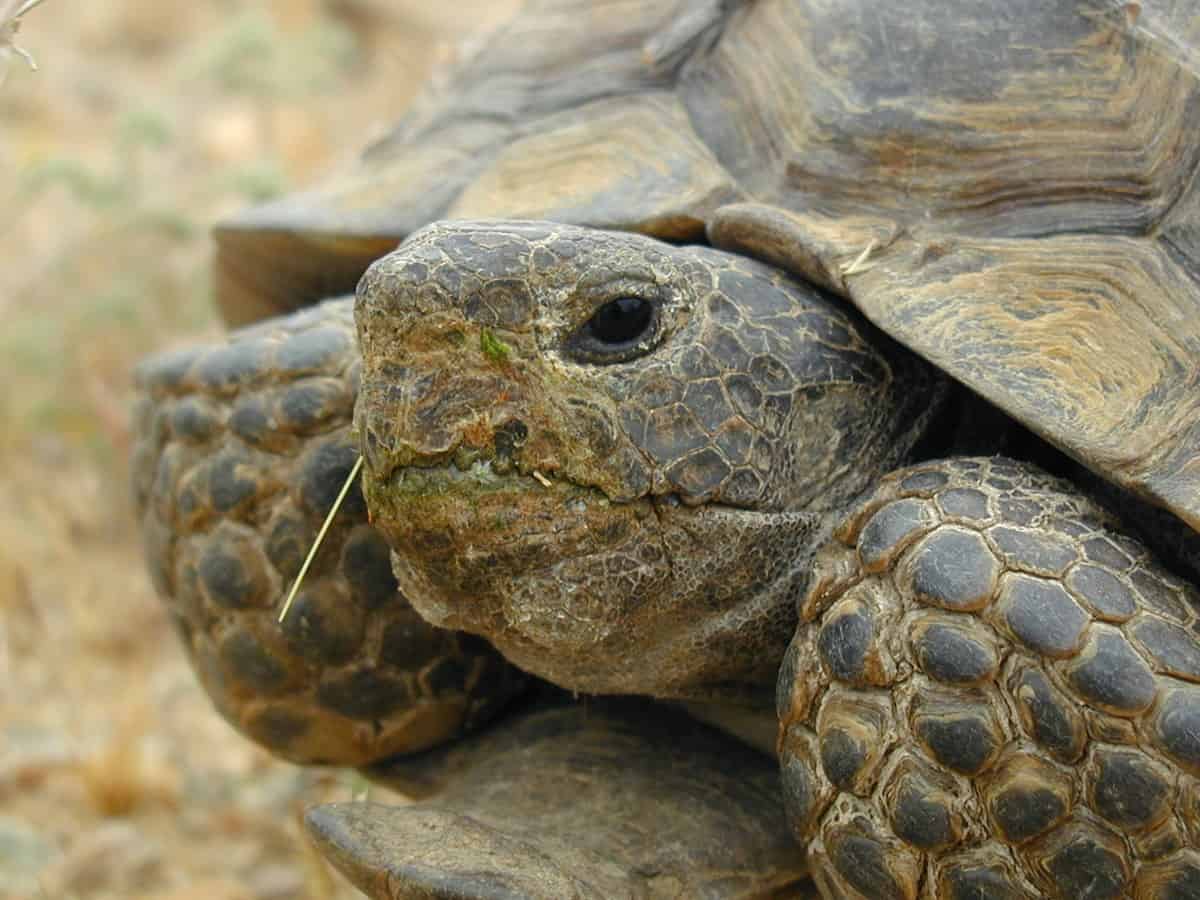
Since they are extremely slow animals, tortoises can’t really catch any living prey, so they adapted by being herbivores. Some tortoise species can digest animal matter, and sometimes they catch other slow animals, such as snails, slugs, and insects. They can also feed on carcasses.
What Do Tortoises Eat in the Wild?
When in the wild, tortoises feed on various plants, such as clover, alfalfa grass, aloe, barley, hay, grains, hibiscus leaves, mulberry leaves, Bermuda grass, and sowthistle grass, but they also feed on fungi, carrion, mushrooms, pears, apples, and some animals such as snails, etc.
Their diet also depends on the place where they live. Mediterranean Tortoises graze on shrubs, weeds, and succulents. Arid and tropical tortoises feed on cactus pads, prickly pears and other cacti, stems, flowers, grass, and leaves.
Jungle tortoises mostly feed on fruits, flowers, and leaves, but they also feed on fungi, grasses, and occasionally, amphibians and invertebrates.
What Do Pet Tortoises Eat?
You should feed your pet tortoise with food that is similar to their food in the wild. Also, different tortoise species might need different foods.
For example, Greek, Russian, and Hermann’s tortoise should eat dark leafy greens (kale, parsley, broccoli, spinach, lettuce), hay, grass, and commercial tortoise pellet food.
Red-footed tortoise can eat all of these foods, plus insects, such as mealworms, worms, crickets, and roaches. Tortoises can also eat fruits, such as melon, kiwi, strawberries, grapes, apples, etc.
Sulcata tortoise and leopard tortoise should feed primarily on grass and hay. When possible, try to place them outside in your backyard. They are grazers and will enjoy munching on your lawn. You can occasionally add dandelions to their diet, along with prickly pear cactus.
The food for pet tortoises should be supplemented with calcium powder and reptile vitamins. To increase their protein intake, pet tortoises can also eat small amounts of cat food or lean meat every two weeks.
What Do Pet Turtles Eat?
As semi-aquatic animals and omnivores, pet turtles require a different diet than pet tortoises. They eat pellets, leafy green plants and vegetables, insects, and feeder fish. At least once a year, their food needs to be enriched with calcium supplements and other minerals.
The best plants and vegetables for feeding pet turtles are kale, spinach, broccoli, cucumber, turnips, mustard greens, bell peppers, dandelion greens, and collard greens. The best insects for feeding pet turtles are crickets, beetles, moths, mealworms, and grasshoppers.
Depending on how big your pet turtle is, you can feed it with goldfish, guppies, and minnows. The turtles eat those fish whole, including the bones.
What Do Baby Pet Tortoises and Turtles Eat?
Baby tortoises should be fed leafy greens, green vegetables, grass, and occasionally, fruit. Make sure that those plants are without roots and that they don’t have too many flowers, to avoid choking.
Some of the best plants for baby tortoises are alfalfa hey, timothy hay, dandelion, clover, ribgrass plantain, sow thistle, red deadnettle, and Aloe vera, etc.
Vegetables and fruits your baby tortoise could eat involve watermelon, blueberries, cauliflower, zucchini, celery, carrot tops, etc. However, fruits should only be occasional treats and not the main meal.
How Do Tortoises Forage Their Food?
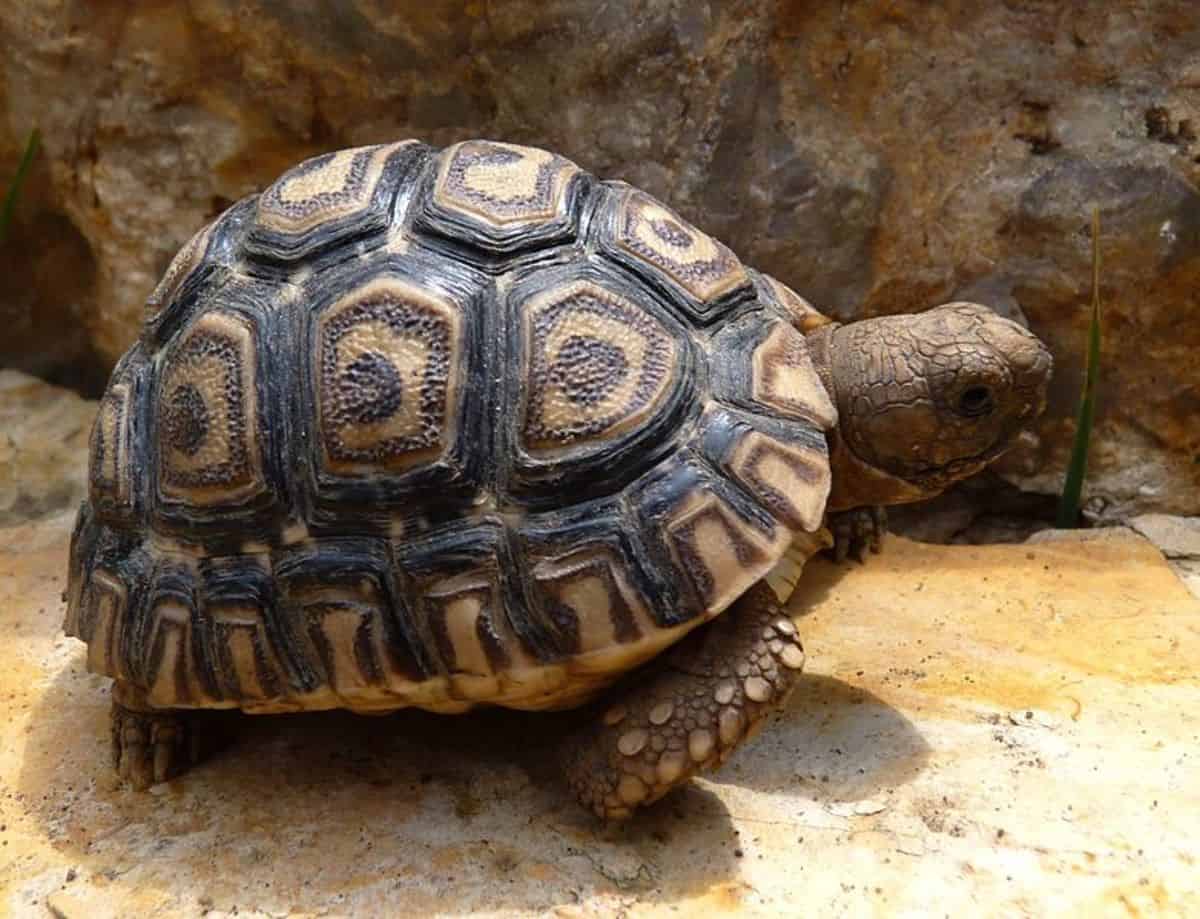
Tortoises are quite slow, so they can’t really run after their prey. Instead, they spend most of their days foraging for food. They prefer to look for food sources near their burrows, and only rarely do they travel for more than one hundred feet.
These reptiles mostly rely on their scent when searching for food. However, their sight is also good and they can even see during the dusk or dawn when the visibility is much lower. This allows them to hunt most of the day, and sometimes during the night.
Nevertheless, tortoises and turtles don’t have a good hearing, and they can only hear sounds above 60 decibels, which is another disadvantage when it comes to hunting.
How Do Tortoises Chew Their Food?
Since turtles and tortoises don’t have teeth, they need to use their beaks to chew on their food. Their beaks have sharp edges both in the upper and the lower jaw.
Turtles can bite and chew their food just as effectively as if they had teeth thanks to these pointed edges and their powerful head muscles. Some turtles with soft shells have rounded lips as opposed to beaks. They use their powerful tongues to force food down their throats because they are unable to chew.
What Can Tortoises Not Eat?
Although tortoises can eat a lot of things and they actually thrive on a varied diet, there are still some foods they shouldn’t eat. For example, they can’t eat beans or peas because these foods can damage their kidney and liver.
Tortoises shouldn’t eat toxic plants like iris, juniper, ivy, poinsettia, ficus, begonia, and plants from the nightshade family. Also, asparagus, avocado, citrus fruits, chili peppers, and buttercup should also be excluded from tortoise diets.
Apart from vegetables and plants, there are also some fish that shouldn’t be eaten by tortoises. For example, tortoises shouldn’t eat smelt and mackerel because those fish have high-fat content and could cause health problems.
Although tortoises can eat most fruits and enjoy munching on them, you should restrict their fruit intake to once a month because fruits are full of sugars. Fruits should make up to 10% of tortoises die, and the rest of their diet should be high-fiber food, such as grass, hay, leaves, etc,
How To Properly Feed Your Tortoise?
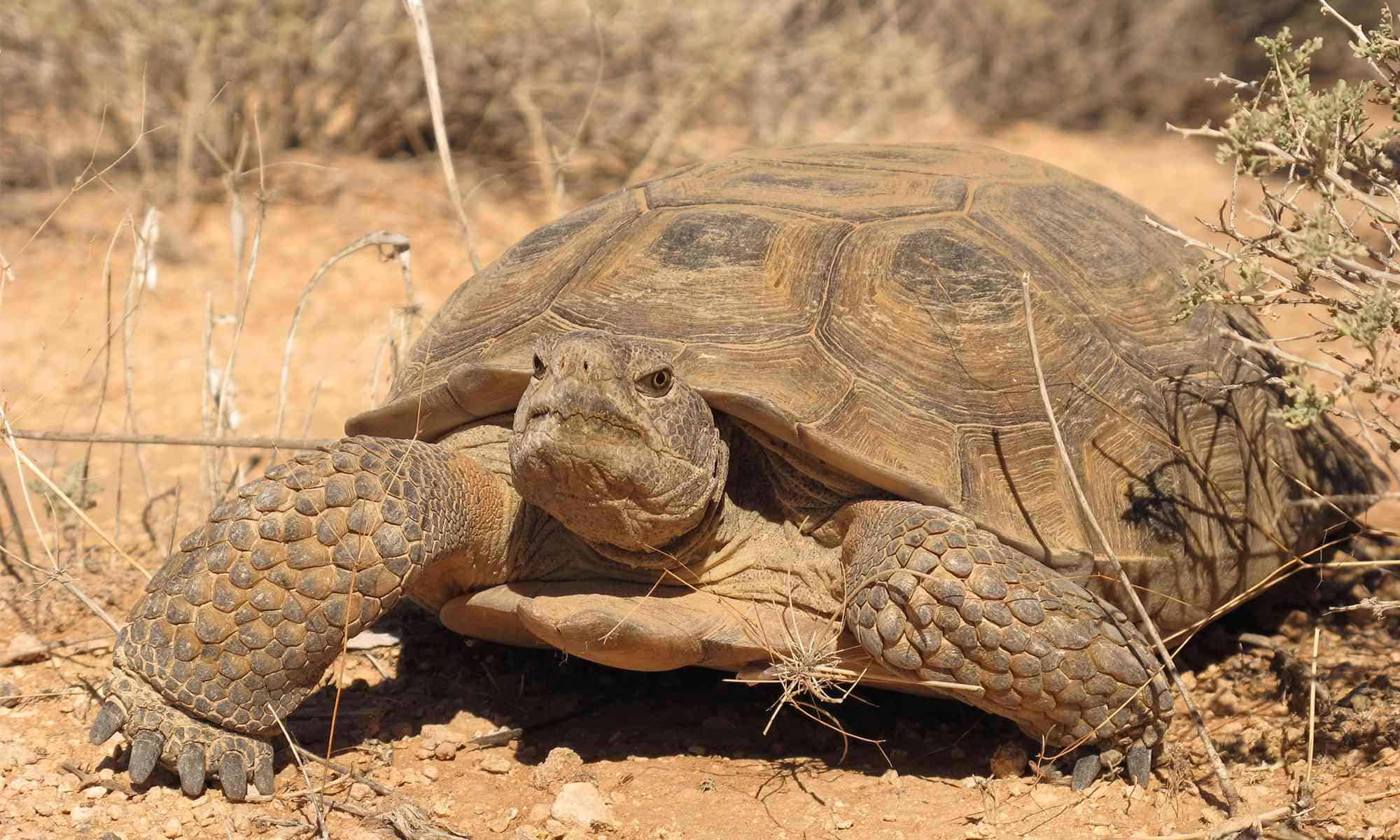
When it comes to feeding pet tortoises, there are some rules to follow to make sure they stay healthy and well-fed with all the nutrients they need. Turtles and tortoises should only eat fresh food, so you should always remove uneaten food from their enclosures.
Feeding Frequency
Many tortoise owners wonder how often they should feed their pets, and the answer depends on the age and size of the tortoise. Baby tortoises and smaller tortoises need to eat more often than adult tortoises.
Baby tortoises and younger species need to eat at least once a day. When they grow up, it will be enough to feed them every second or third day, depending on the particular tortoise and the nutritional value of their meals.
If you own an aquatic turtle, the feeding schedule should be similar. Baby turtles should be fed more frequently, each day, and more mature specimens every two or three days.
What about the size of the meal? The rule of thumb says the meal should be as big as the tortoises/turtle’s shell. You shouldn’t overfeed your tortoises, but you shouldn’t starve them either.
The Importance of Calcium in Tortoises’ Diet
Adding calcium to your tortoise’s diet is crucial for its health. Calcium helps tortoises to grow their shells and bones, and it also helps them digest their food. Female and juvenile tortoises need more calcium than male specimens.
Calcium can be given to tortoises in the form of phosphorus-free calcium power, and tortoise blocks or you can buy cuttlefish, which is not only rich in calcium but also helps your tortoise shape and maintain its beak.
When planning to get a pet turtle or tortoise, always do your research. Make sure to research what that particular species consumes in its natural habitat. Not every species has the same feeding habits, and while some species might thrive under a certain diet regimen, others might suffer from malnutrition.
How To Take Care of Pet Turtles?
Pet turtles are considered to be beginner pets that even children can take care of. However, although they are not high maintenance when compared to some other pets, that doesn’t mean that turtles require no care at all and that they can be neglected.
Turtles have long life spans, which needs to be taken into consideration when choosing them as a pet. It is a long time commitment, and you should be ready to take care of your animal for several decades.
Tank
Turtles need a proper tank that will be big enough to allow them to grow to their adult size. The turtle tank should be at least 40 gallons big. Every tank should have a UV light lamp for basking.
Depending on whether you have an aquatic turtle or a land tortoise, their tank should have a dry area and swimming area. Tortoises don’t actually know how to swim, but they can bathe in shallow water. Tanks should be kept clean and the water needs to be changed frequently.
Temperature
Turtles need their enclosure temperature to be between 60 and 90 degrees Fahrenheit. If it gets lower, they will either start hibernating or get sick. The UV lamp will also help maintain adequate tank temperature.
If the tank contains water for swimming, water should also be heated. Turtles and tortoises are cold-blooded animals that can’t regulate their body temperature, and hence, they depend on their surrounding’s temperature.
Handling Tips
Turtles and tortoises don’t like to be handled too often. They are better when watched than when touched. If you try to play with them too often, they can become stressed. Never drop your turtle, although it has a hard shell.
Always wash your hands thoroughly after touching the turtles. They are known to be carriers of salmonella, and you risk contamination if you don’t wash your hands properly.
The Best Pet Turtles and Tortoises
Usually, pet owners look for turtles and tortoises that won’t grow too big. With that in mind, the most popular pet turtle/tortoise species are:
- Red-eared slider: This turtle species is native to the Southern United States. It grows to 6-7 inches on average, and its estimated lifespan is 20-30 years.
- Box Turtles: These turtles are native to North America and Asia. They grow up to 5 inches and live for 40 years on average, although many lived for more than 100 years.
- Painted Turtle: Native to North and Central America, this turtle grows up to 5-10 inches, and it has an average lifespan of 20-30 years.
- Russian Tortoise: This tortoise comes from Pakistan, Afghanistan, and some parts of China and India. It can grow up to10 inches and live on average for 40 years.
- Greek Tortoise: This tortoise is originally from Africa and Southern Europe. When adult, it reaches 10 inches and lives for 50 years on average.
- Red-Footed Tortoise: A red-footed tortoise lives in several countries of South America. It can grow for up to 10-16 inches, and its average life span is 50 years.
What Are the Predators of Tortoises?
Baby tortoises and turtles are the most vulnerable to various predators, especially in the first few hours of hatching. However, adult tortoises are also in danger. Coyotes, eagles, ravens, chimpanzees, snakes, raccoons, and bearded vultures, are only some of the many animals that prey on tortoises.
Humans are also one of the deadliest tortoise predators. We have been hunting tortoises for their meat and beautiful shells for many centuries. As usual, excess hunting and environmental impact on their habitats endangered many tortoise species.
Conclusion
Turtles and tortoises are great as low-maintenance pets, but there are still so many things one needs to know before getting one. There are many differences between aquatic turtles and land tortoises, which means those animals require different foods, tanks, and other conditions.
Both groups need a varied diet enriched with calcium to stay healthy. They also need clean and big enough tanks, warm temperatures and lots of light, and access to clean water.
Did you ever have a pet turtle or tortoise? Would you get one for your family and why? Write in the comments!
